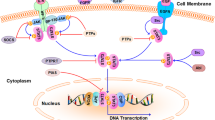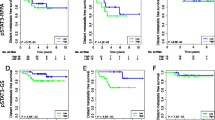Abstract
Signal transducer and activator of transcription 3 (STAT3) is a point of convergence for numerous oncogenic signaling pathways. In breast cancer cell lines and xenograft models activated STAT3 participates in breast tumorigenesis, while studies in humans have demonstrated that phosphorylated (tyrosine705)-STAT3 is a marker of good prognosis in breast cancer. In order to resolve this paradox we hypothesized that in clinic, phospho-STAT3 has a predictive role of benefit from adjuvant chemotherapy; therefore the goal of this study was to determine the usefulness of phospho-STAT3 status as a predictor of benefit from adjuvant chemotherapy in breast cancer patients. Immunohistochemical analysis of phospho-STAT3 was performed on a tissue microarray of breast cancer specimens. The expression pattern of phospho-STAT3 was retrospectively correlated with pathological parameters and overall survival in patients who were or were not treated with adjuvant chemotherapy. Of 375 tissue specimens interpretable for phospho-STAT3, 134 (36 %) exhibited positive phospho-STAT3 nuclear expression. Among 234 patients who received adjuvant therapy, those with tumors displaying positive phospho-STAT3 nuclear expression had a better ten-year rate of overall survival than patients with tumors displaying negative phospho-STAT3 nuclear expression (P = 0.001). Among patients who did not received adjuvant chemotherapy, positive phospho-STAT3 nuclear status was not correlated with increased overall survival (P = 0.54). Positive phospho-STAT3 was correlated with improved overall survival only among patients who received adjuvant chemotherapy in a multivariate analysis adjusted for stage, grade, hormonal status, Her2 status, and age, irrespective of the chemotherapy regimen received (hazard ratio for death, 0.35 [95 % CI 0.188–0.667]; P = 0.001). These findings support the role of phospho-STAT3 as a marker of favorable outcome in breast cancer patients treated with adjuvant chemotherapy. Whether phospho-STAT3 has a predictive role of benefit from adjuvant chemotherapy has to be validated on prospective, randomized, controlled studies.

Similar content being viewed by others
Abbreviations
- STAT3:
-
Signal transducer and activator of transcription 3
- ER:
-
Estrogen receptor
- HR:
-
Hormonal receptor
- TIMP1:
-
Tissue inhibitor of metalloproteinase-1
- CAF:
-
Cyclophophamide adriamicin 5FU
- CMF:
-
Cyclophophamide methotrexate 5FU
References
Palmieri C, Jones A (2012) ÚThe 2011 EBCTCG polychemotherapy overview. Lancet 379(9814):390-392
Levy DE, Lee CK (2002) What does Stat3 do? J Clin Investig 109(9):1143–1148
Calo V, Migliavacca M, Bazan V, Macaluso M, Buscemi M, Gebbia N, Russo A (2003) STAT proteins: from normal control of cellular events to tumorigenesis. J Cell Physiol 197(2):157–168
Sonnenblick A, Levy C, Razin E (2004) Interplay between MITF, PIAS3, and STAT3 in mast cells and melanocytes. Mol Cell Biol 24(24):10584–10592
Hodge DR, Hurt EM, Farrar WL (2005) The role of IL-6 and STAT3 in inflammation and cancer. Eur J Cancer 41(16):2502–2512
Yoshimura A (2006) Signal transduction of inflammatory cytokines and tumor development. Cancer Sci 97(6):439–447
Leslie K, Lang C, Devgan G, Azare J, Berishaj M, Gerald W, Kim YB, Paz K, Darnell JE, Albanese C, Sakamaki T, Pestell R, Bromberg J (2006) Cyclin D1 is transcriptionally regulated by and required for transformation by activated signal transducer and activator of transcription 3. Cancer Res 66(5):2544–2552
Diaz N, Minton S, Cox C, Bowman T, Gritsko T, Garcia R, Eweis I, Wloch M, Livingston S, Seijo E, Cantor A, Lee JH, Beam CA, Sullivan D, Jove R, Muro-Cacho CA (2006) Activation of stat3 in primary tumors from high-risk breast cancer patients is associated with elevated levels of activated SRC and survivin expression. Clin Cancer Res 12(1):20–28
Gritsko T, Williams A, Turkson J, Kaneko S, Bowman T, Huang M, Nam S, Eweis I, Diaz N, Sullivan D, Yoder S, Enkemann S, Eschrich S, Lee JH, Beam CA, Cheng J, Minton S, Muro-Cacho CA, Jove R (2006) Persistent activation of stat3 signaling induces survivin gene expression and confers resistance to apoptosis in human breast cancer cells. Clin Cancer Res 12(1):11–19
Garcia R, Bowman TL, Niu G, Yu H, Minton S, Muro-Cacho CA, Cox CE, Falcone R, Fairclough R, Parsons S, Laudano A, Gazit A, Levitzki A, Kraker A, Jove R (2001) Constitutive activation of Stat3 by the Src and JAK tyrosine kinases participates in growth regulation of human breast carcinoma cells. Oncogene 20(20):2499–2513
Watson CJ, Miller WR (1995) Elevated levels of members of the STAT family of transcription factors in breast carcinoma nuclear extracts. Br J Cancer 71(4):840–844
Perou CM, Jeffrey SS, van de Rijn M, Rees CA, Eisen MB, Ross DT, Pergamenschikov A, Williams CF, Zhu SX, Lee JC, Lashkari D, Shalon D, Brown PO, Botstein D (1999) Distinctive gene expression patterns in human mammary epithelial cells and breast cancers. Proc Natl Acad Sci USA 96(16):9212–9217
Berclaz G, Altermatt HJ, Rohrbach V, Siragusa A, Dreher E, Smith PD (2001) EGFR dependent expression of STAT3 (but not STAT1) in breast cancer. Int J Oncol 19(6):1155–1160
Dolled-Filhart M, Camp RL, Kowalski DP, Smith BL, Rimm DL (2003) Tissue microarray analysis of signal transducers and activators of transcription 3 (Stat3) and phospho-Stat3 (Tyr705) in node-negative breast cancer shows nuclear localization is associated with a better prognosis. Clin Cancer Res 9(2):594–600
Sonnenblick A, Shriki A, Galun E, Axelrod JH, Daum H, Rottenberg Y, Hamburger T, Mali B, Peretz T (2012) Tissue microarray-based study of patients with lymph node-positive breast cancer shows tyrosine phosphorylation of signal transducer and activator of transcription 3 (tyrosine705-STAT3) is a marker of good prognosis. Clin Transl Oncol 14(3):232–236
Kononen J, Bubendorf L, Kallioniemi A, Barlund M, Schraml P, Leighton S, Torhorst J, Mihatsch MJ, Sauter G, Kallioniemi OP (1998) Tissue microarrays for high-throughput molecular profiling of tumor specimens. Nat Med 4(7):844–847
Nechemia-Arbely Y, Barkan D, Pizov G, Shriki A, Rose-John S, Galun E, Axelrod JH (2008) IL-6/IL-6R axis plays a critical role in acute kidney injury. J Am Soc Nephrol 19(6):1106–1115
McShane LM, Altman DG, Sauerbrei W, Taube SE, Gion M, Clark GM (2006) REporting recommendations for tumor MARKer prognostic studies (REMARK). Breast Cancer Res Treat 100(2):229–235
Gariboldi MB, Ravizza R, Molteni R, Osella D, Gabano E, Monti E (2007) Inhibition of Stat3 increases doxorubicin sensitivity in a human metastatic breast cancer cell line. Cancer Lett 258(2):181–188
Barbieri I, Pensa S, Pannellini T, Quaglino E, Maritano D, Demaria M, Voster A, Turkson J, Cavallo F, Watson CJ, Provero P, Musiani P, Poli V (2010) Constitutively active Stat3 enhances neu-mediated migration and metastasis in mammary tumors via upregulation of Cten. Cancer Res 70(6):2558–2567
Barbieri I, Quaglino E, Maritano D, Pannellini T, Riera L, Cavallo F, Forni G, Musiani P, Chiarle R, Poli V Stat3 is required for anchorage-independent growth and metastasis but not for mammary tumor development downstream of the ErbB-2 oncogene. Mol Carcinog 49(2):114–120
Dien J, Amin HM, Chiu N, Wong W, Frantz C, Chiu B, Mackey JR, Lai R (2006) Signal transducers and activators of transcription-3 up-regulates tissue inhibitor of metalloproteinase-1 expression and decreases invasiveness of breast cancer. Am J Pathol 169(2):633–642
Chapman RS, Lourenco PC, Tonner E, Flint DJ, Selbert S, Takeda K, Akira S, Clarke AR, Watson CJ (1999) Suppression of epithelial apoptosis and delayed mammary gland involution in mice with a conditional knockout of Stat3. Genes Dev 13(19):2604–2616
Sarosiek KA, Malumbres R, Nechushtan H, Gentles AJ, Avisar E, Lossos IS (2010) Novel IL-21 signaling pathway up-regulates c-Myc and induces apoptosis of diffuse large B-cell lymphomas. Blood 115(3):570–580
Monnien F, Zaki H, Borg C, Mougin C, Bosset JF, Mercier M, Arbez-Gindre F, Kantelip B (2010) Prognostic value of phosphorylated STAT3 in advanced rectal cancer: a study from 104 French patients included in the EORTC 22921 trial. J Clin Pathol 63(10):873–878
Choi CH, Song SY, Kang H, Lee YY, Kim CJ, Lee JW, Kim TJ, Kim BG, Lee JH, Bae DS (2010) Prognostic significance of p-STAT3 in patients with bulky cervical carcinoma undergoing neoadjuvant chemotherapy. J Obstet Gynaecol Res 36(2):304–310
Kim KW, Mutter RW, Cao C, Albert JM, Shinohara ET, Sekhar KR, Lu B (2006) Inhibition of signal transducer and activator of transcription 3 activity results in down-regulation of Survivin following irradiation. Mol Cancer Ther 5(11):2659–2665
Acknowledgments
This study was supported by grants from Hadassah medical center (AS), ICA—Israeli cancer association (AS), the ROSETREES TRUST (AS), APF—American physicians’ fellowship for medicine in Israel (AS). David S. Lando Memorial fund (AS), Raymond F. Schinazi International program (AS), Deutsche Forschungsgemeinschaft, Bonn, Germany SFB841 (EG).
Conflict of interest
All authors indicated no financial or other conflicting interests that are relevant to the subject matter under consideration in this article.
Author information
Authors and Affiliations
Corresponding author
Electronic supplementary material
Below is the link to the electronic supplementary material.
Rights and permissions
About this article
Cite this article
Sonnenblick, A., Uziely, B., Nechushtan, H. et al. Tumor STAT3 tyrosine phosphorylation status, as a predictor of benefit from adjuvant chemotherapy for breast cancer. Breast Cancer Res Treat 138, 407–413 (2013). https://doi.org/10.1007/s10549-013-2453-x
Received:
Accepted:
Published:
Issue Date:
DOI: https://doi.org/10.1007/s10549-013-2453-x




